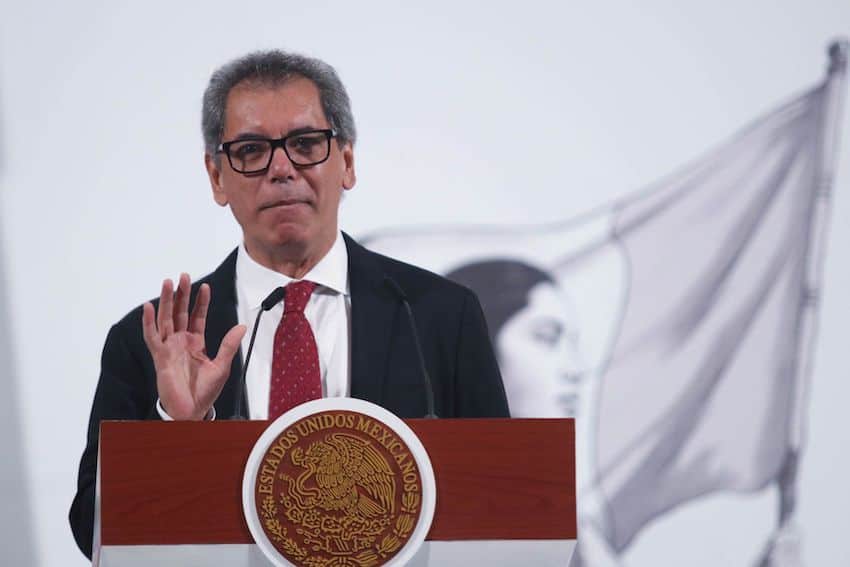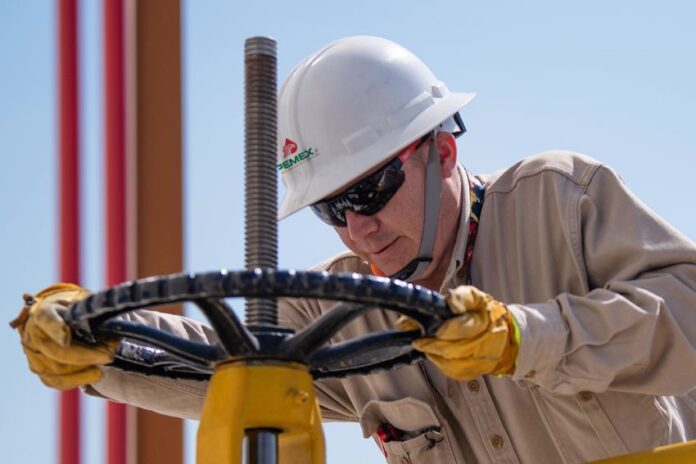Financial self-sufficiency starting in 2027 is among the objectives of a 10-year strategic plan for the heavily indebted state oil company Petróleos Mexicanos (Pemex).
Among the other goals of the Comprehensive Capitalization and Financing Strategy are to significantly reduce Pemex’s debt and increase the domestic production of natural gas, a fuel that the United States currently supplies to Mexico in large quantities.
Federal officials presented the plan at President Claudia Sheinbaum’s morning press conference on Tuesday, four days after Fitch Ratings upgraded Pemex’s long-term issuer default ratings and a week after the Finance Ministry announced the placing of US $12 billion in a debt offering to support the state oil company.
Sheinbaum told reporters that the government has carried out a “meticulous revision” of Pemex and created a “vision” for the future of the company, which last week reported debt of around $99 billion.
“What we have is a comprehensive vision,” said the president, who asserted that by 2027, Pemex won’t require any financial support from the federal Finance Ministry.
Finance Minister: Pemex’s debt to decline 26% below 2019 level by 2030
Finance Minister Édgar Amador Zamora noted that the Finance Ministry, the Energy Ministry, Pemex and federal development bank Banobras worked on the plan for the state oil company.
He presented data that showed that Pemex’s debt increased from $43.3 billion in 2008 to $105.8 billion in 2018, the final year of the administration of former president Enrique Peña Nieto.
Amador said that by the end of this year, Pemex’s debt is forecast to have declined to $88.8 billion, 16% lower than in 2018.
He said that the Comprehensive Capitalization and Financing Strategy, “through a series of efforts” and “operations,” will allow Pemex to reduce its debt by 26% compared to 2019, the first full year of the presidency of Andrés Manuel López Obrador.
The forecast Amador presented showed Pemex’s debt at $77.3 billion in 2030.

He said that the government’s plan, which includes supporting Pemex to make significant debt repayments this year and next, will enable the state oil company to reach a “very sound” liquidity position that will allow it to finance its own operating expenses starting in 2027.
Amador highlighted that the previous federal government, under López Obrador, (gradually) reduced Pemex’s Shared Profit (DUC) levy from 65% to 30%.
“That has contributed to a very significant improvement in the liquidity position, the financial strength … of Petróleos Mexicanos,” he said.
The name of the levy was changed by the Sheinbaum administration to Derecho Petrolero para el Bienestar — a tax on oil for “well-being.”
Sheinbaum stressed that the “well-being” tax on non-associated natural gas is just 12%, and asserted that the low rate “allows Pemex to capitalize.”
She said that in 2025 and 2026 Pemex has to pay “very high amortizations of its debt” as well as interest payments and will therefore require Finance Ministry support in the short term.
“But in 2027, thanks to all the work the Finance Ministry has done, Pemex will go out on its own; it won’t need support from the Finance Ministry,” Sheinbaum said.
Reuters reported that $5.1 billion of Pemex’s bond debt is due for repayment this year, followed by $18.7 billion in 2026 and $7.7 billion in 2027.
The 3 main pillars of the Pemex plan
Amador said that the Pemex strategy has three main “ejes” (pillars or central tenets).
- The “determination” of the Derecho Petrolero para el Bienestar, set at a rate of 30% for oil and 12% for non-associated natural gas.
Amador said that the lower levy rates “optimize” (i.e. reduce) Pemex’s tax burden and incentivize the company to carry out “a very efficient productive investment strategy in the long term.”
- Support from the Finance Ministry that allows Pemex to reduce its debt.
Amador noted that the government has already supported the state oil company to pay down its debt, including with last week’s debt offering and cash injections. He indicated that additional support will be provided this year and next, but will cease in 2027.
- Monetary support to finance “productive investment.”
#Mexico: “Pemex Is at a Crossroads.” Recommended from @CSISAmericas senior associate @ignandez.
Mexico could be a net oil importer by 2030. “The key issue dragging Pemex is its $101 billion debt pile, making it the world’s most indebted oil company.”🎯https://t.co/I9ps6o97Z2 pic.twitter.com/PQqN24fCGh
— Ryan Berg, PhD (@RyanBergPhD) August 1, 2025
Banobras general director Jorge Mendoza Sánchez said that a 250-billion-peso (US $13.3 billion) investment vehicle has been created to fund oil sector projects in 2025 alone.
He said that the “investment fund” will be financed by state-owned development banks, commercial banks and “the investment public in general.”
“… It’s important to mention that this action reaffirms the commitment we have within Banobras and [Mexico’s other] development banks to continue supporting Petróleos Mexicanos,” Mendoza said.
“… It will be an attractive [investment] vehicle and, in addition, it will have a guarantee from the federal government, which will make its financing cost very low,” he said.
Energy minister outlines ‘clear objectives’ of Pemex plan
Energy Minister Luz Elena González Escobar enumerated a list of “clear objectives” of the 2025-35 plan for Pemex. They include:
- Guaranteeing “stable” oil production of 1.8 million barrels per day.
- Increasing production of “high-value” oil products (gasoline, diesel, jet fuel) in support of the aim of achieving self-sufficiency for fuel.
- “Relaunching” Mexico’s petrochemicals industry and increasing the production of fertilizers “to support food sovereignty.”
- Increasing natural gas production.
- Supporting renewable energy initiatives in order to reduce greenhouse gas emissions.
González asserted that the government’s plan will resolve Pemex’s “structural challenges” and set it up for a successful future.
She also said that “energy sovereignty” is “at the center of the second story of the fourth transformation” — i.e., achieving energy sovereignty is a key priority of the Sheinbaum administration, which says it is continuing the “transformation” initiated by the 2018-24 López Obrador government.
Mexico’s gas production falls short as US imports surge to record levels
Pemex CEO outlines ‘operational plan’ for state oil company
The strategy for Pemex over the next 10 years is “fundamentally” aimed at “increasing the revenue, reducing the costs and improving the financial profile” of the state oil company, said CEO Víctor Rodríguez Padilla.
He said that Pemex would do a range of things to achieve those goals. They include:
- Developing two large Gulf of Mexico oil fields, namely Zama and Trion.
- “Reactivating” oil production at fields that still have “potential.”
- Increasing natural gas production by taking advantage of the “resources we have both in the south and north” of the country.
- “Rebuilding the entire petrochemicals system.”
- Building three new gas pipelines that connect to economic development hubs.
- Resolving gas supply problems on the Yucatán Peninsula.
- Building “four cogeneration plants” in Hidalgo (Tula), Oaxaca (Salina Cruz), Veracruz (Cangrejera) and Tabasco (Nuevo Pemex).
- Improving the “marketing of the products we sell” in order to “have better sales.”
- Developing renewable projects, including solar and wind ones.
- Exploiting lithium resources.
Rodríguez said that Pemex “is and will continue to be a key player in the well-being and sustainable development of the country.”
The state oil company has seven refineries in Mexico, including the recently built Olmeca Refinery on the Tabasco coast. It also owns a refinery in Texas, and operates gas stations across Mexico.
Last week, Pemex reported its first quarterly profit in a year, even as crude and natural gas production declined in annual terms between April and June. An appreciation of the Mexican peso against the US dollar allowed Pemex to overcome a drop in revenues and record a profit in Q2 of 2025.
With reports from El Economista, La Jornada, Milenio, El Universal and Reuters
